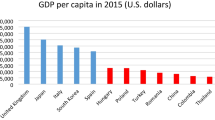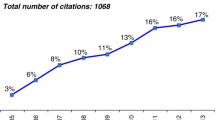Abstract
Technological Specialization in Industrial Countries: Patterns and Dynamics. — This paper employs distribution dynamics and patent data to study the empirical dynamics of technological specialization in industrial countries. Large countries spread innovation activities across a wider range of technologies, and their specialization level in a field displays lower probability to move around its initial level (country size effects). Mobility is high and asymmetric: it is difficult to improve specialization in very disadvantaged technologies, while high comparative advantages revert towards lower specialization levels. These findings undermine the theory of technological accumulation and path dependence, its implication of persistence in trade specialization patterns and the effectiveness of targeted industrial and technology policies.
Similar content being viewed by others
References
Amendola, G., P. Guerrieri, and P. C. Padoan (1998). International Patterns of Technological Accumulation and Trade. In D. Archibugi and J. Michie (eds.),Trade, Growth and Technical Change. New York: Cambridge University Press.
Amiti, M. (1999). Specialization Patterns in Europe.Weltwirtschaftliches Archiv 135 (4): 573–593.
Anderson, T. W., and L. A. Goodman (1957). Statistical Inference about Markov Chains.Annals of Mathematical Statistics 28 (1): 89–110.
Archibugi, D., and M. Pianta (1992a). Specialization and Size of Technological Activities in Industrial Countries: The Analysis of Patent Data.Research Policy 21 (1): 79–93.
Archibugi, D., and M. Pianta (1992b).The Technological Specialization of Advanced Countries. Dordrecht: Kluwer Academic; Brussels: Commission of European Communities.
Archibugi, D., and M. Pianta (1994). Aggregate Convergence and Sectoral Specialization in Innovation.Journal of Evolutionary Economics 4(1): 17–33.
Balassa, B. (1965). Trade Liberalization and Revealed Comparative Advantage.The Manchester School of Economic and Social Studies 33 (2): 99–123.
Basawa, I. V., and B. L. S. Prasaka Rao (1980).Statistical Inference for Stochastic Processes. London: Academic Press.
Bottazzi L., and G. Peri (1999). Innovation, Demand and Knowledge Spillovers: Theory and Evidence from European Regions. CEPR Discussion Paper 2279. Centre for Economic Policy Research, London.
Brasili A., P. Epifani, and R. Helg (2000). On the Dynamics of Trade Patterns.De Economist 148 (2): 233–257.
Bulli, S. (2001). Distribution Dynamics and Cross-Country Convergence: A New Approach.Scottish Journal of Political Economy 48 (2): 226–243.
Cantwell, J. (1989).Technological Innovation and Multinational Corporations. Oxford: Basil Blackwell.
Cefis, E., and L. Orsenigo (2001). The Persistence of Innovative Activities: A Cross-Country and Cross-Sector Analysis.Research Policy, forthcoming.
Cohen W. M., and D. A. Levinthal (1990). Absorptive Capacity: A New Perspective on Learning and Innovation.Administrative Science Quarterly 35 (1): 128–152.
Cowell, F. A. (1995).Measuring Inequality. London: Simon and Schuster International, Harvester Wheatsheaf./Prentice Hall.
Dosi, G. (1988). Sources, Procedures and Microeconomic Effects of Innovation.Journal of Economic Literature 26 (3): 1120–1171.
Eaton J., R. Evenson, S. Kortum, P. Marino,and J. Putnam (1999). Technological Specialization in International Patenting. In G. Saxonhouse and T. N. Srinivasan (eds.),Development, Duality and International Economic Regime: Essays in Honor of Gustav Ranis. Ann Arbor: Michigan University Press.
Friedman, M. (1992). Do Old Fallacies Ever Die?Journal of Economic Literature 30(4): 2129–2132.
Geweke, J., Marshall, R., and G. Zaekin (1986). Mobility Indices in Continuous Time Markov Chains.Econometrica 54 (6): 1407–1423.
Griliches, Z. (1990). Patent Statistics as Economic Indicators: A Survey.Journal of Economic Literature 28(4): 1661–1707.
Grossman, G. M., and E. Helpman (1991).Innovation and Growth in the Global Economy. Cambridge: MIT Press.
Hotelling, H. (1932). Review of The Triumph of Mediocrity in Business by Horace Secrist.Journal of the American Statistical Association 28 (184): 463–465.
Jaffe, A. B. (1986). Technological Opportunity and Spillovers of R&D: Evidence from Firms’ Patents, Profits and Market Value.American Economic Review 76 (5): 984–1001.
Jaffe, A. B. (1989). Real Effects of Academic Research.American Economic Review 79 (5): 957–970.
Jaffe, A. B., M. Trajtenberg, and R. Henderson (1993). Geographical Localization of Knowledge Spillovers as Evidenced by Patent Citations.Quarterly Journal of Economics 108 (3): 577–598.
Keller, W. (2000). Geographic Localization of International Technology Diffusion. NBER Working Paper 7509. National Bureau of Economic Research. Cambridge, Mass.
Laursen K. (2000). Do Export and Technological Specialization Patterns Co-Evolve in Terms of Convergence or Divergence? Evidence from 19 OECD Countries, 1971–1991.Journal of Evolutionary Economics 10(4): 415–436.
Malerba, F. (1992). Learning by Firms and Incremental Technical Change.Economic Journal 102(413): 845–859.
Nelson, R. R. (1993).National Innovation Systems: A Comparative Analysis. Oxford: Oxford University Press.
Nelson, R. R., and S. Winter (1982).An Evolutionary Theory of Economic Change. Cambridge, Mass.: Belknap Press.
Patel, P., and K. L. R. Pavitt (1991). Europe’s Technological Performance. In C. Freeman, M. Sharp, and W. Walker (eds.),Technology and the Future of Europe: Global Competition and the Environment in the 1990s. London: Frances Pinter Publishers.
Proudman, J., and S. Redding (1998). Persistence and Mobility in International Trade. CEPR Discussion Paper 1802. Centre for Economic and Policy Research. London.
Proudman, J., and S. Redding (2000). Evolving Patterns of International Trade.Review of International Economics 8 (3): 373–396.
Putnam, J. (1996). The Value of International Patent Rights. Ph.D. Diss., Yale University.
Quah, D. T. (1993a). Empirical Cross-Section Dynamics in Economic Growth.European Economic Review 37 (2-3): 426–434.
Quah, D. T. (1993b). Galton’s Fallacy and the Tests for the Convergence Hypothesis.Scandinavian Journal of Economics 95 (4): 427–443.
Quah, D. T. (1996a). Twin Peaks: Growth and Convergence in Models of Distribution Dynamics.Economic Journal 106(437): 1045–1055.
Quah, D. T. (1996b). Aggregate and Regional Disaggregate Fluctuations.Empirical Economics 21 (1): 137–159.
Quah, D. T. (1996c). Convergence Empirics across Economies with (some) Capital Mobility.Journal of Economic Growth 1 (1): 95–124.
Quah, D. T. (1997). Empirics for Growth and Distribution: Stratification, Polarization, and Convergence Clubs.Journal of Economic Growth 2(1): 27–59.
Romer, P. (1990). Endogenous Technological Change.Journal of Political Economy 98 (5): 71–102.
Silverman, B.W. (1986).Density Estimation for Statistics and Data Analysis. New York: Chapman and Hall.
Shorrocks, A. F. (1978). The Measurement of Mobility.Econometrica 46(5): 1013–1024.
Soete, L. (1981). A General Test of Technological Gap Trade Theory.Weltwirtschaftliches Archiv 117 (4): 638–660.
Stolpe M. (1995).Technology and the Dynamics of Specialization in Open Economies. Tübingen: Mohr Siebeck.




